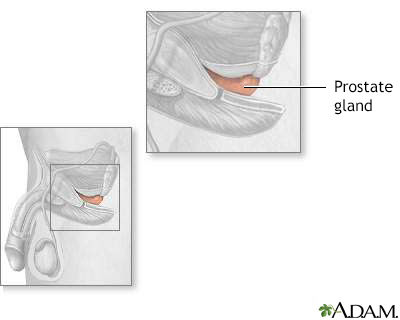Pregnancy SmartSiteTM
TURP; Prostate resection - transurethral DefinitionTransurethral resection of the prostate (TURP) is a surgery to remove the inside part of the prostate gland. It is done in order to treat symptoms of an enlarged prostate. DescriptionThe surgery takes about 1 to 2 hours. You will be given medicine before surgery so you don't feel pain. You may get general anesthesia in which you are asleep and pain-free or spinal anesthesia in which you are awake, but numb from the waist and below. Your surgeon will insert a scope through the tube that carries urine from your bladder out of the penis. This instrument is called the resectoscope. A special cutting tool is placed through the scope. It is used to remove the inside part of your prostate gland using electricity. Why the Procedure Is PerformedYour health care provider may recommend this surgery if you have benign prostatic hyperplasia (BPH). The prostate gland often grows larger as men get older. The larger prostate may cause problems with urinating. Removing part of the prostate gland can often make these symptoms better. TURP may be recommended if you have:
Before you have surgery, your provider will suggest you make changes in how you eat or drink. You may also be asked to try taking medicine. Part of your prostate may need to be removed if these steps do not help. TURP is one of the most common types of prostate surgery. Other procedures are also available. Your provider will consider the following when deciding on the type of surgery:
RisksRisks for any surgery are:
Additional risks are:
Before the ProcedureYou will have many visits with your provider and tests before your surgery. Your visit will include:
If you are a smoker, you should stop several weeks before the surgery. Your provider can give you tips on how to do this. Always tell your provider what medicines, vitamins, and other supplements you are taking, even ones you bought without a prescription. During the weeks before your surgery:
On the day of your surgery:
After the ProcedureYou will most often stay in the hospital for 1 to 3 days. In some cases, you may be allowed to go home the same day. After surgery, you will have a small tube, called a Foley catheter, in your bladder to remove urine. Your bladder may be flushed with fluids (irrigated) to keep it clear of clots. The urine will look bloody at first. In most cases, the blood goes away within a few days. Blood can also seep around the catheter. A special solution may be used to flush out the catheter and keep it from getting clogged with blood. The catheter will be removed within 1 to 3 days for most people. You will be able to go back to eating a normal diet right away. Your health care team will:
You may need to wear tight stockings and use a breathing device to keep your lungs clear. You may be given medicine to relieve bladder spasms. Outlook (Prognosis)TURP relieves symptoms of an enlarged prostate most of the time. You may have burning with urination, blood in your urine, frequent urination, and need to urgently urinate. This usually resolves after a little bit of time. ReferencesHan M, Partin AW. Simple prostatectomy: open and robotic-assisted laparoscopic approaches. In: Partin AW, Domochowski RR, Kavoussi LR, Peters CA, eds. Campbell-Walsh-Wein Urology. 12th ed. Philadelphia, PA: Elsevier; 2021:chap 147. Milam DF. Transurethral resection and transurethral incision of the prostate. In: Smith JA Jr, Howards SS, Preminger GM, Dmochowski RR, eds. Hinman's Atlas of Urologic Surgery. 4th ed. Philadelphia, PA: Elsevier; 2019:chap 67. Parsons JK, Dahm P, Kohler TS, Lerner LB, Wilt TJ. Surgical management of lower urinary tract symptoms attributed to benign prostatic hyperplasia: AUA Guideline Amendment 2020. J Urol. 2020;204(3):799-804. PMID: 32698710 pubmed.ncbi.nlm.nih.gov/32698710/. Roehrborn CG, Strand DW. Benign prostatic hyperplasia: etiology, pathophysiology, epidemiology, and natural history. In: Partin AW, Domochowski RR, Kavoussi LR, Peters CA, eds. Campbell-Walsh-Wein Urology. 12th ed. Philadelphia, PA: Elsevier; 2021:chap 144. | |
| |
Review Date: 7/1/2023 Reviewed By: Kelly L. Stratton, MD, FACS, Associate Professor, Department of Urology, University of Oklahoma Health Sciences Center, Oklahoma City, OK. Also reviewed by David C. Dugdale, MD, Medical Director, Brenda Conaway, Editorial Director, and the A.D.A.M. Editorial team. The information provided herein should not be used during any medical emergency or for the diagnosis or treatment of any medical condition. A licensed medical professional should be consulted for diagnosis and treatment of any and all medical conditions. Links to other sites are provided for information only -- they do not constitute endorsements of those other sites. No warranty of any kind, either expressed or implied, is made as to the accuracy, reliability, timeliness, or correctness of any translations made by a third-party service of the information provided herein into any other language. © 1997- A.D.A.M., a business unit of Ebix, Inc. Any duplication or distribution of the information contained herein is strictly prohibited. | |

 Male reproductive ...
Male reproductive ... Prostate gland
Prostate gland
